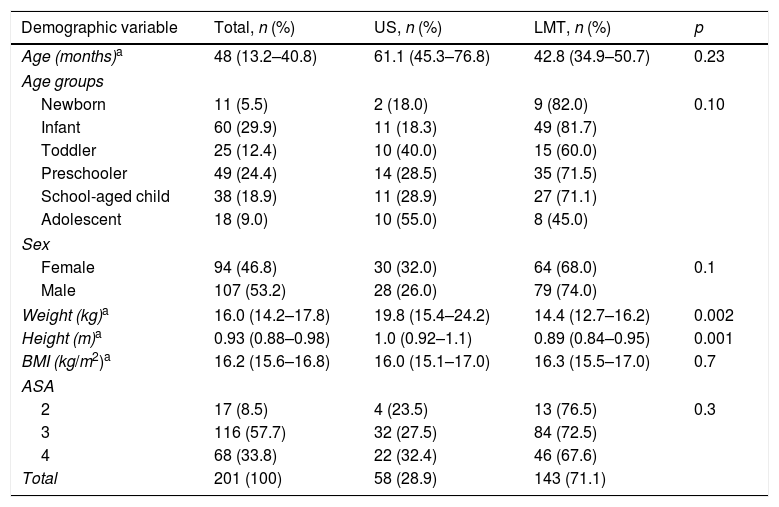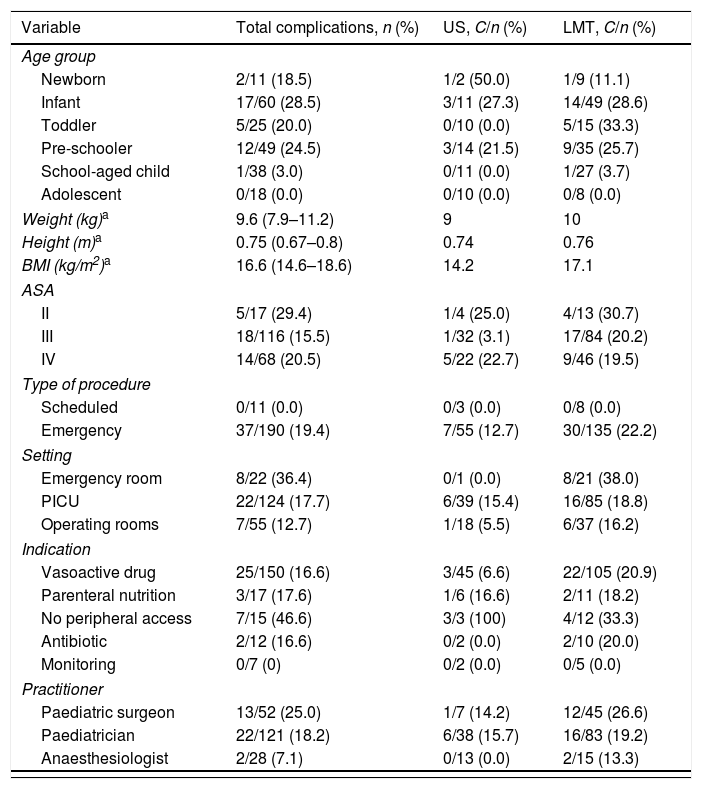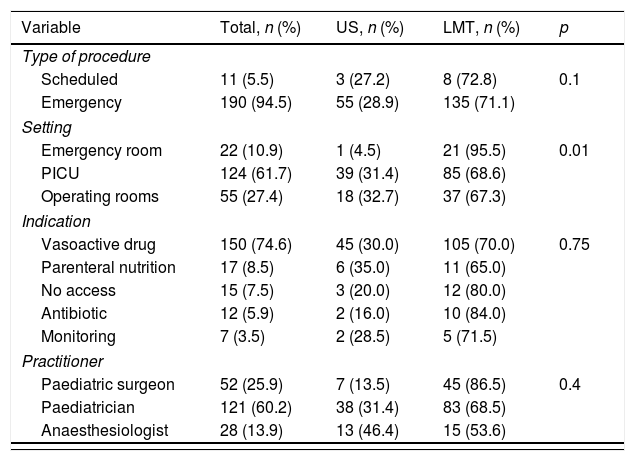The insertion of a central venous line in children and adolescents is technically more difficult, due to the smaller size of the structures. This can lead to an increase in immediate complications, which can be reduced when using ultrasound. In our institution, the percentage of these complications and the use of ultrasound are unknown.
ObjectiveTo describe the frequency of immediate complications of central venous catheterisation guided by the ultrasound in a general university hospital, compared to the anatomical landmarks technique in children less than 18 years of age.
Materials and methodsObservational, retrospective, and analytical study, comparing the frequency of complications with two central venous catheterisation techniques: anatomical landmarks and ultrasound, according to the clinical records of procedures performed from June to November 2016.
ResultsA total of 201 procedural records were analysed, of which 71% were with landmarks, and 29% with ultrasound. The overall incidence of immediate complications was 18.4%, with 12% using ultrasound and 21% using landmarks (OR: 0.5; 95 CI: 0.2–1.2). Children under 5 years of age presented with 90% of the complications, the most frequent being the impossibility of passing the guide (29.7%) and multiple punctures (24.3%). There was no arterial puncture with use of ultrasound. Ultrasound was used by 13.4% of paediatric surgeons, by 32.4% of paediatricians, and 46.4% of anaesthetists, with complications of 25%, 19%, and 7%, respectively. The main indication for catheterisation was the need for vasoactive agents (74%), with the procedure being more complicated in patients with no peripheral venous accesses (46%). The success rate with anatomical landmarks was 77.6%, compared to 91.4% with ultrasound.
ConclusionCentral venous catheterisation with ultrasound guidance in children under 18 reduces immediate complications by 42.8% and improves the success rate by 13.8%.
En pediatría, la canalización venosa central presenta mayor dificultad técnica debido al menor tamaño de las estructuras, aumentando las complicaciones inmediatas, siendo reducidas al usar la ultrasonografía. En nuestra institución se desconoce el porcentaje de estas complicaciones y del uso del ultrasonido (US).
ObjetivoDescribir la frecuencia de complicaciones inmediatas de la canalización venosa central guiada por US comparada con la técnica de referencias anatómicas (RA) en menores de 18años en un hospital universitario general.
Materiales y métodosEstudio observacional, retrospectivo y analítico, comparando frecuencia de complicaciones con dos técnicas de canalización venosa central: RA y US según los registros clínicos de procedimientos realizados de junio a noviembre de 2016.
ResultadosSe analizaron 201 registros de procedimientos: el 71% con RA y el 29% con US. La incidencia global de complicaciones inmediatas fue del 18,4%: del 12% con US y del 20,9% con RA (OR: 0,5; IC95%: 0,2-1,2). Los menores de 5años presentaron el 90% de las complicaciones, siendo las más frecuentes la imposibilidad de pasar la guía (29,7%) y múltiples punciones (24,3%); con US no hubo ninguna punción arterial. La utilización de US por cirujanos pediátricos fue del 13,4%, por pediatras el 32,4% y por anestesiólogos el 46,4%, presentando complicaciones del 25, del 19 y del 7%, respectivamente. La indicación principal de canalización venosa central fue necesidad de vasoactivos (74%), complicándose más los pacientes que llegaron al procedimiento sin accesos venosos periféricos (46%). La tasa de éxito con RA fue del 77,6% y con US, del 91,4%.
ConclusiónLa canalización venosa central con guía US en menores de 18años reduce las complicaciones inmediatas en un 42,8% y mejora la tasa de éxito en un 13,8%.











